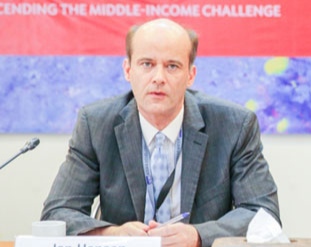
As we have done previously, we will provide a quick overview of the international outlook, focusing on the prospects for the net money economy. The presentation will be shared with you after the event for further details. Let’s begin with some key messages for the international outlook.
First, most developing Asian economies experienced accelerated growth in the first half of 2024, driven by domestic demand and robust export growth. Second, inflation continued to moderate across the region as many central banks kept policy rates steady, creating more space for monetary policy easing, particularly after the recent rate cuts by the US Federal Reserve.
Compared to our April projections, the 2024 growth forecast has been adjusted upwards by 0.1 percentage points, reaching 5.0%. However, downside risks remain, including rising protectionism tied to the US presidential election outcome, geopolitical tensions, continued weakness in China’s property market, and adverse weather events.
Regional Developments
In the first half of 2024, developing Asia maintained strong growth. China, however, faces lingering weaknesses in its property sector, which has impacted consumer sentiment and household spending. Despite these challenges, economic policy stimulus has partly compensated, and growth is expected to stay at 5.0%.
Meanwhile, India’s economy has decelerated slightly but is still projected to grow by a solid 7% this year, fueled by government spending and private consumption. This makes South Asia the fastest-growing sub-region in Asia and the Pacific.
Exports and Industrial Performance
Exports across Asia have been supported by semiconductors, particularly in East Asian economies with high-tech industries. Industrial production has remained strong in India and other major regional economies, as reflected in the Purchasing Managers’ Index (PMI) trends.
Inflation and Monetary Policy
Inflationary pressures eased across the region during the first seven months of 2024. In developing Asia, inflation is now below pre-pandemic levels, with China reporting a particularly low rate of just 0.5% in July. Progress in reducing inflation has created more room for monetary policy easing, as 12 out of 17 inflation-targeting economies saw inflation fall below target. Many central banks are expected to cut interest rates further, particularly following the US Fed’s 50-basis point rate reduction.
Fiscal Policy
Fiscal positions are expected to improve across most economies with large deficits. For example, Nepal’s fiscal deficit is projected to narrow in 2024. Improvements in revenue generation and lower expenditure have contributed to better fiscal balances.
Global Economic Trends
The 2024 growth projections for major advanced economies have been revised upwards slightly, reaching 1.5%. This adjustment is due to faster-than-expected growth in the US, now forecast at 2.4%, and modest improvements in the euro area, where growth is expected to be 0.8%. Declining inflation has allowed for monetary easing, which will further support growth next year.
Food prices have declined by 9% so far this year, with wheat and maize prices dropping by 7%. This trend was influenced by India easing its export restrictions on rice, which helped to dampen global price pressures.
Outlook for Developing Asia
Growth in developing Asia is expected to remain robust, with forecasts marginally increased to 5.0% for 2024 and 4.9% for 2025. Southeast Asia will remain the fastest-growing sub-region, driven largely by India, with growth forecasts at 6.3% in 2024. Inflation projections for the region have been revised downward to 2.8% for this year and 2.9% for 2025, while South Asia’s inflation rate is projected at 7.0% in 2024 and 6.1% in 2025.
Risks to the Economic Outlook
Short-term risks include rising protectionism, geopolitical tensions, further deterioration in China’s property market, and weather-related disruptions in key economies like India. These factors could lead to renewed supply chain issues, higher food and energy prices, and increased uncertainty for the global and regional economic outlook.
The article is a written form of a speech by Jan Hansen, Principal Economist of the Asian Development Bank, during the disclosure of the Asian Development Outlook 2024.








